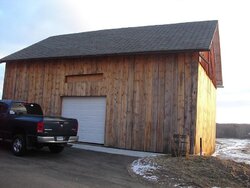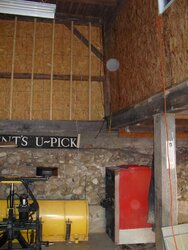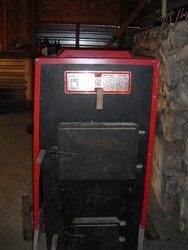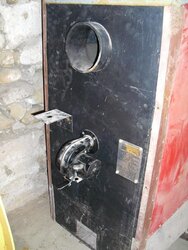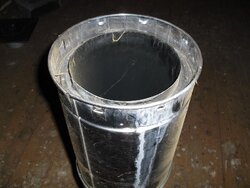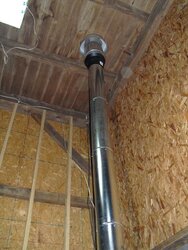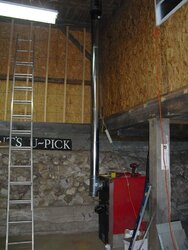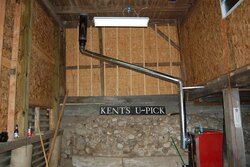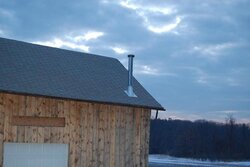hello everyone. great site! alot of good info and humor here!
i have decided to hook up my steel king forced hot air wood furnace as the primary source of heat in my shop. the furnace has never been fired and has been sitting patiently in my basement for 25+ years waiting to be used. my grandfather bought it and never hooked it up. is this a good boiler? i have other options(wood stove and pellett stove) this is my first time ever using a wood fired furnace. i have no clue how to get this thing to work like a furnace. there are no controls.
the furnace has a small combustion blower and a large convection blower. also a spot to install a water jacket.
my plans are to come out of the back of furnace with a 90*then up 12 inches to my magic heat then 7 feet up to the ceiling where the 6 inch single wall will be expanded to 7 inch. then use a single wall to double wall adapter then i'm using double wall stainless 7 inch all the way out. total run will be about 30 feet. like i said this is going to be in my shop. the first 10 feet is going to be inside the the next 20ish will be outside. does this plan sound ok? do i need to install a berometric damper in the run? if so, where?
what do i need to get to get this boiler in motion? there are no controls. (i dont have a manual) i am assuming that the wood boiler works like a gas or oil boiler. thermostat calls for heat, combustion fan comes on and stokes the fire. then when it comes up to temp the circulation fan comes on and presto! the shop has heat. is this correct? if so what do i need to make this happen? also, there are no air adjustments on the stove. does it draw all it's air through the blower?
thanks for any help! really want to get this up and running so i can finish the shop! fingers dont work well at 20* down there!
i have decided to hook up my steel king forced hot air wood furnace as the primary source of heat in my shop. the furnace has never been fired and has been sitting patiently in my basement for 25+ years waiting to be used. my grandfather bought it and never hooked it up. is this a good boiler? i have other options(wood stove and pellett stove) this is my first time ever using a wood fired furnace. i have no clue how to get this thing to work like a furnace. there are no controls.
the furnace has a small combustion blower and a large convection blower. also a spot to install a water jacket.
my plans are to come out of the back of furnace with a 90*then up 12 inches to my magic heat then 7 feet up to the ceiling where the 6 inch single wall will be expanded to 7 inch. then use a single wall to double wall adapter then i'm using double wall stainless 7 inch all the way out. total run will be about 30 feet. like i said this is going to be in my shop. the first 10 feet is going to be inside the the next 20ish will be outside. does this plan sound ok? do i need to install a berometric damper in the run? if so, where?
what do i need to get to get this boiler in motion? there are no controls. (i dont have a manual) i am assuming that the wood boiler works like a gas or oil boiler. thermostat calls for heat, combustion fan comes on and stokes the fire. then when it comes up to temp the circulation fan comes on and presto! the shop has heat. is this correct? if so what do i need to make this happen? also, there are no air adjustments on the stove. does it draw all it's air through the blower?
thanks for any help! really want to get this up and running so i can finish the shop! fingers dont work well at 20* down there!


